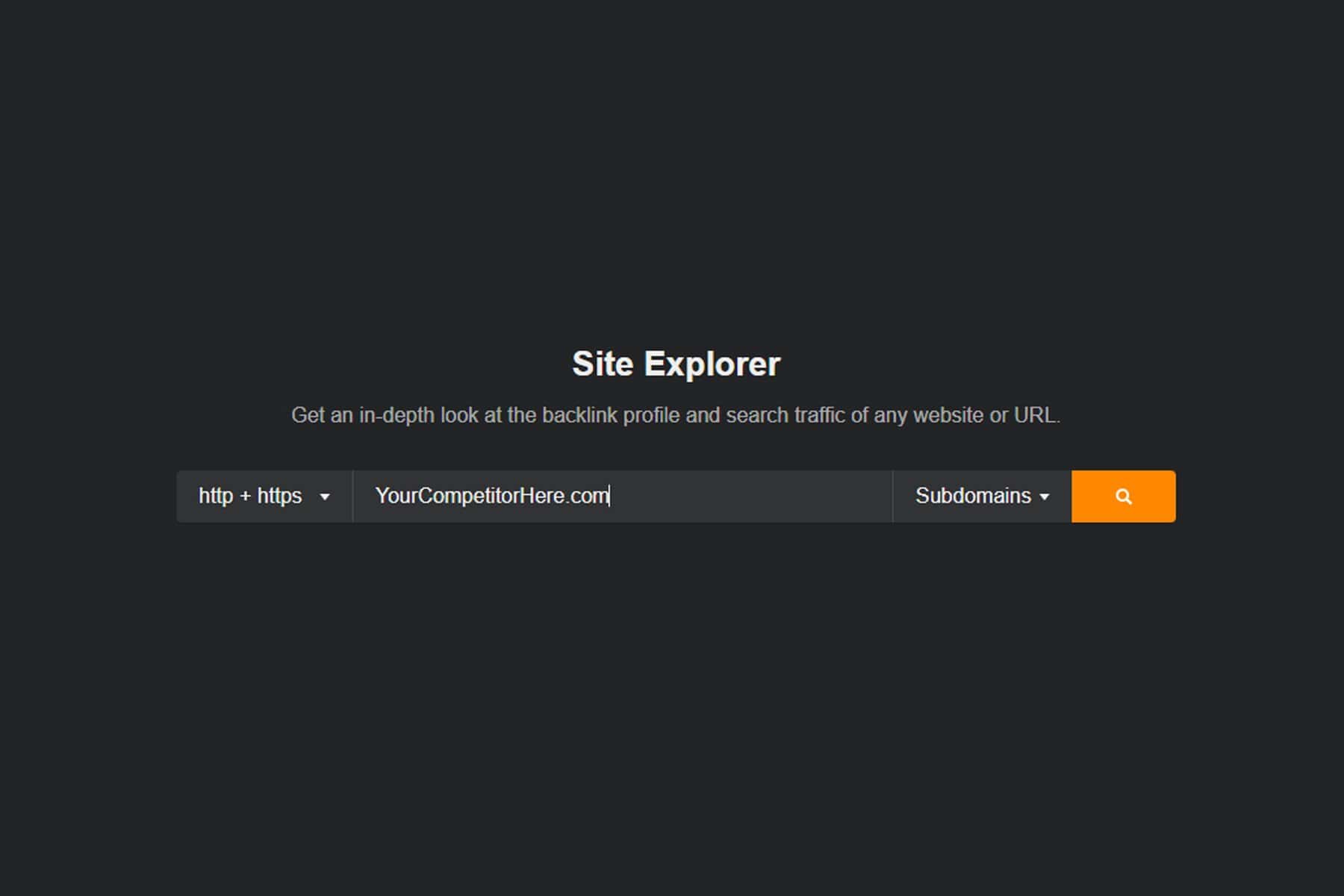Competitor Backlink Gap Analysis
If you’re struggling to build backlinks (consistently), observing and studying how your competitors are doing it is an excellent starting point.
Understanding your competitors’ backlink profiles will open doors, allowing you to formulate your own strategies for building backlinks and in turn, improving your rankings.
One of the most simple ways to improve rankings is to check competitor backlinks and to build similar backlinks. Or you could earn backlinks from the exact same websites. If you can earn backlinks from the same websites as your competitors, think of it as evening the playing field, nulling each other out.
Analysing competitor backlink profiles will reveal low-hanging fruit backlinks that you can build with minimal resources. It will also show you the types of backlinks competitors are earning, which can act as inspiration or direct guidance for your own campaigns.
In this blog, we’ll teach you how to find your competitors, how to check competitor backlinks and how to calculate an estimated number of backlinks needed to rank for a specific keyword.
How to Find Your SEO Competitors
You probably already know who your competitors are, but your SEO competitors need more consideration. The real-world businesses that are in direct competition with you are likely also SEO competitors, but that’s not always the case.
Real-world business competitors are the companies that are directly competing with yours in the marketplace by offering similar products or services.
On the other hand, your SEO competitors are any websites that rank for the same keywords as your business in search engine results pages (SERPs). They may or may not be in direct competition with you, but they are definitely vying for the same search real estate as you.
The Battle for Search Real Estate
Search real estate is the general term for the valued space on SERPs, the top-ranking positions for any keyword.
The higher up a website ranks on search engines, the more visibility they have and the more organic search traffic they will earn. Most search engine users will click the first results, so it’s important to rank highly for valuable keywords.
For example, if you were customer.io, a customer engagement platform, you could earn search traffic and organic signups by ranking highly for keywords like “customer engagement platform” or “messaging automation”.
As you can see below, customer.io ranks 18th for “customer engagement platform”, placing them on page 2 of Google.
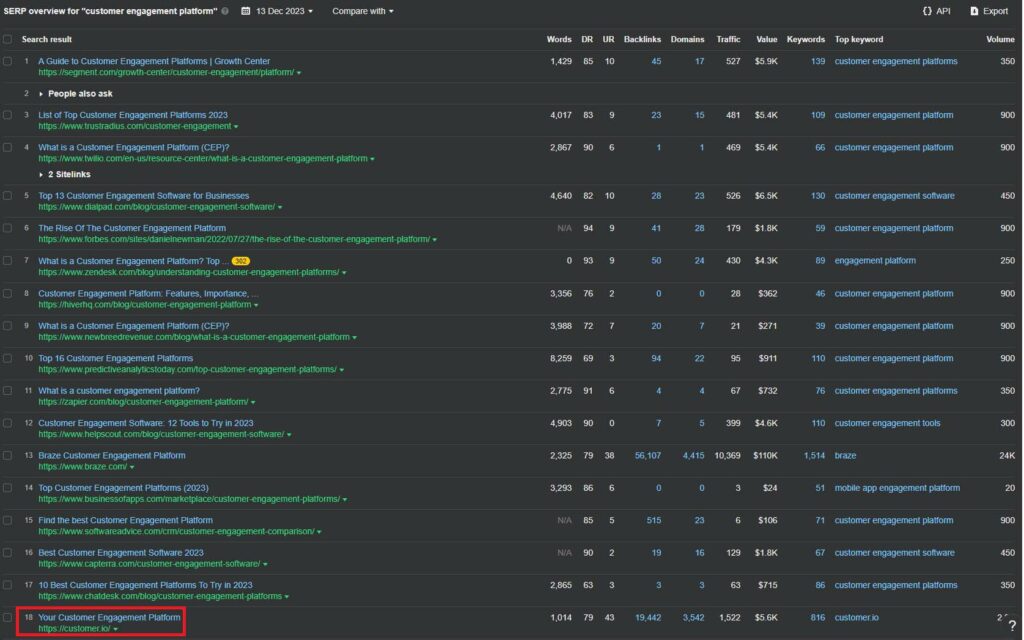
The battle for search real estate is a race to the top of the SERPs. Websites with stronger SEO will win more search real estate by meeting the needs of search engine algorithms and by satisfying search intent.
But how do you outrank competitors on search, exactly?
Backlink building is one of the most effective and straightforward ways to improve search engine rankings. When a contextually-relevant website links to yours, it indicates to Google (and other search engines like Bing) that your website is trustworthy and deserves to be ranked higher than other sites. Building relevant backlinks is a surefire way to earn organic search traffic.
Backlinks act as votes of confidence in the eyes of big G and the stronger the backlink, the stronger the vote of confidence is for your website. The link equity sent to your site through a backlink varies due to a number of factors, but mainly the authority of the website linking to you, its contextual relevance to your page and its contextual relevance to your overall domain.
The more quality backlinks to your site you can build, the better.
Think of your backlinks as soldiers in your army, pitted against the soldiers of other websites. The more troops you have, the better your odds of winning search real estate.

How to Identify SEO Competitors in ahrefs
Before we hop into our tutorial on how to use ahrefs to find SEO competitors, let’s first define what an SEO competitor is, exactly. There are 2 types of SEO competitors we consider when building backlinks to improve rankings: page-level and domain-level.
Page-Level Competitors: These are the individual pages that rank for a specific keyword. For example, if you wanted to rank for “veterinary software”, your top page-level competitors would include Capterra, idexx and Vetport.
You can find page-level competitors by searching for a keyword you’re ranking for in ahrefs’ Keywords Explorer and looking at the list of pages ranking for said keyword.
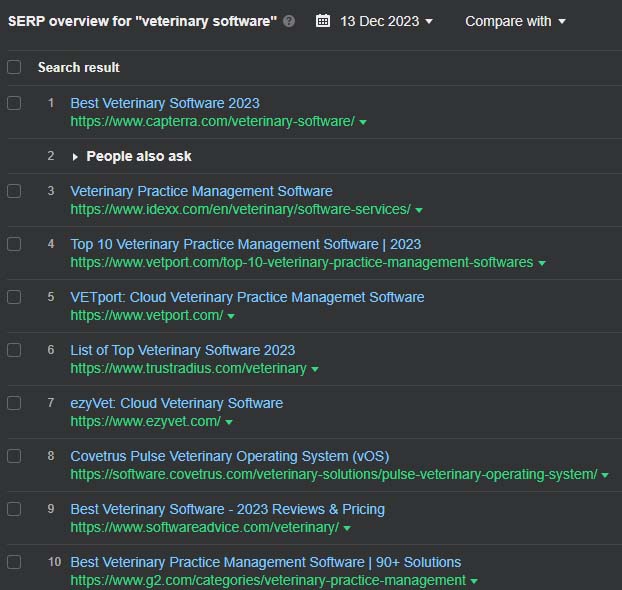
Domain-Level Competitors: Domain-level competitors are the websites that rank for a large number of keywords that your site also ranks for. This type of overlap is called content gap analysis. If you were trying to rank for terms related to “fleet management”, your domain-level competitors would include Geotab and Fleetistics.
You can find domain-level competitors by putting a domain into ahrefs’ Site Explorer and going to the Organic Competitors tab on the left.
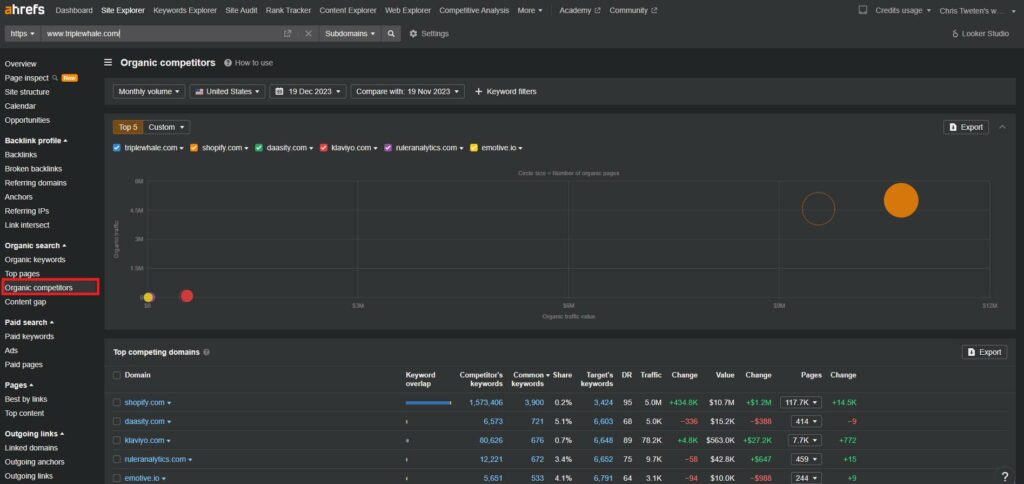
In this example, we looked up Triple Whale’s organic competitors. This is a case of SEO competitors also being real-world business competitors. Most of the sites on the list are rival analytics companies.
How to Check Competitors’ Backlinks
Checking competitors’ backlinks in SEO software is a straightforward process that provides valuable insights into their link building strategies. But fully understanding the data and its implications can be challenging, especially for those who don’t have experience ranking websites.
How to Find Competitor Backlinks with ahrefs
Once you’ve identified who your page-level and domain-level competitors are, it’s time to look up their backlink profiles. This can easily be done in ahrefs’ Site Explorer.
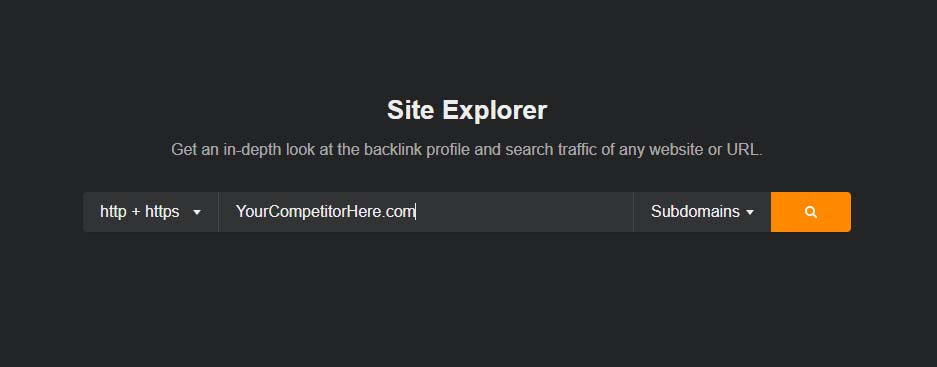
For this example, we’re going to pretend we’re a customer success software trying to compete with ClientSuccess and Gainsight. First we pop their domains into the Site Explorer, then we click on the Backlinks tab to get a full list of their backlinks.
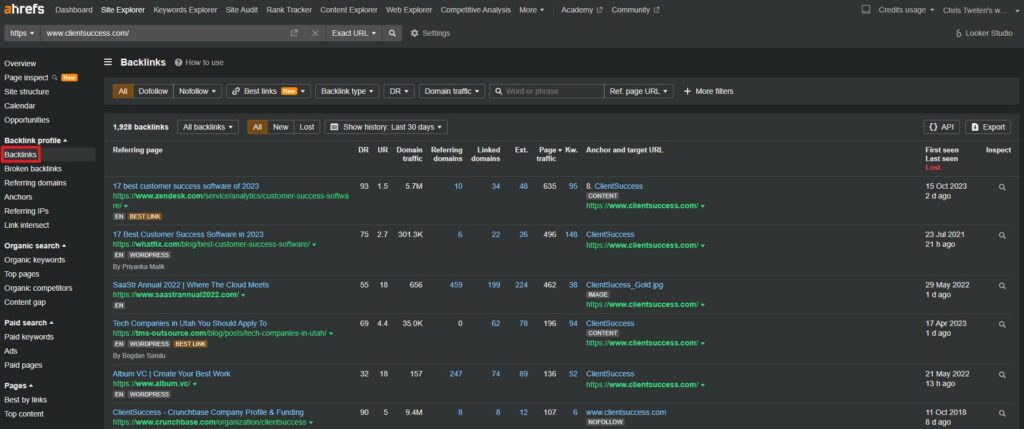
ClientSuccess has a grand total of 1,928 backlinks according to ahrefs, quite the backlink profile to compete with. However, not all of these backlinks are worth paying attention to and not all of them will move the needle for them.
In the next section, we’ll go over how to evaluate competitor backlink profiles in a practical way for planning out backlink building campaigns.
Other SEO Tools to Check Competitors’ Backlinks
Evaluating Competitor Backlink Profiles
To find the truly needle-moving backlinks, we’ll need to apply some filters to narrow the results down from ClientSuccess’ 1,928 backlinks.
First, let’s switch to view only One Link Per Domain. After all, we aren’t going to be building multiple backlinks from the same website, as this is an extremely inefficient use of resources. This brings the backlink total down to 493.
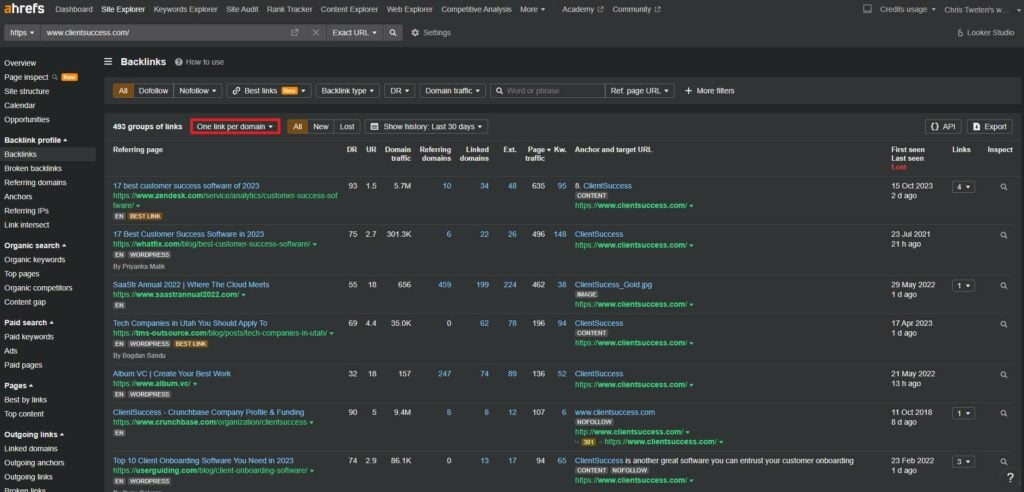
Next, we apply our filters, the same ones outlined in our link prospecting guide.
- dofollow only: Nofollow links are much weaker than dofollow.
- DR 45+: Anything below this will take high volumes of links to improve rankings.
- Domain traffic 1,000+: Sites with less traffic are more likely to be link farms.
This effectively weeds out spammy backlinks, link farms and low authority websites that don’t help improve rankings. The end result is just 82 backlinks that actually move the needle. This is a lot more approachable than the original list of 1,928 backlinks.
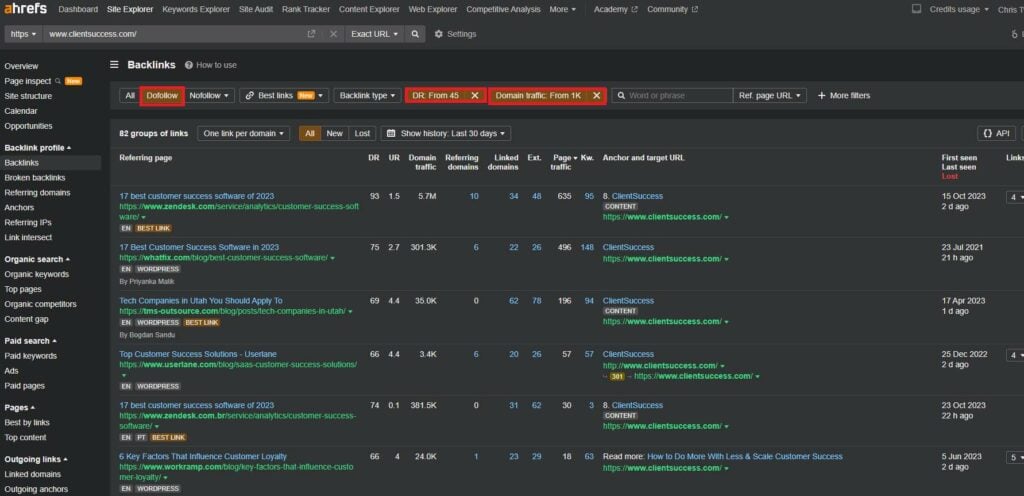
If you want to be extremely thorough when checking competitors’ backlinks, you should repeat the same process for each page-level and domain-level competitor. Once you’ve come up with an estimated number of needle-moving backlinks for each competitor, you’ll have a better idea of how many backlinks you need to play catch-up.
Quality Over Quantity
Improving rankings in search engines requires a strategic approach to backlink building. By analysing the domain traffic, eliminating link farms and low authority websites, we can focus on just the backlinks that truly make a difference.
In the example we gave on ClientSuccess, a customer success software, we found that out of their 1,928 backlinks, only 82 were actually effective in moving the needle. This highlights the importance of quality over quantity when it comes to building backlinks.
